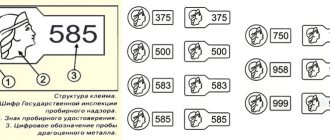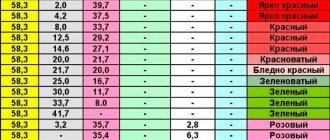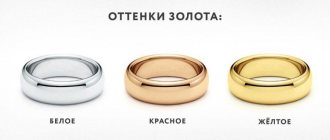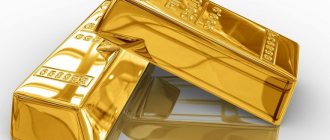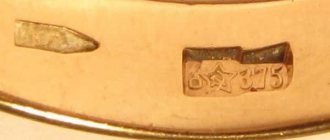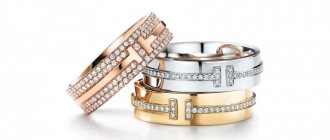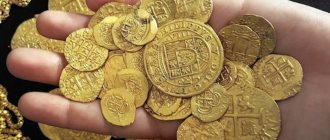Gold + Zinc
Zinc lowers the melting point of the alloy, increases its fluidity, and adds noticeable fragility to the alloy and a greenish tint.
On the territory of Russia, the amount of gold in gold alloys is controlled by the state, and, according to Decree of the Government of the Russian Federation of June 18, 1999 No. 643 “On the procedure for testing and branding products made of precious metals”, the following samples of gold jewelry alloys are possible: 375, 500, 585, 750, 958, 999. Other gold samples are not possible in Russia, so be careful - there are more than enough scammers in this area.
Category “Investing in gold”
Today, counterfeiting jewelry is an extremely profitable business. After all, gold jewelry is small in size. They are convenient for smuggling. They have a high cost per unit volume and, moreover, their production does not require large premises and very complex technologies.
There are many ways to imitate gold.
The simplest is the so-called gypsy gold - copper polished to a golden shine. But usually different alloys are used. Sometimes these are very simple fakes made of brass, roundel, bronze, copper and even iron and aluminum. However, most often, to imitate gold, alloys are used that only an experienced jeweler or expert can distinguish from real gold.
Thus, the following counterfeits are often passed off as precious yellow metal:
7 aluminum bronze (aufir, aural, aufor) – a golden-yellow alloy (consists of 90 parts copper and 10 parts aluminum);
7 bathbronze (bathbronze) – an alloy of bronze and tin (used for gilding and casting of artistic and industrial products;
7 bathmetall – an alloy alloyed with zinc (used in England for the production of tableware);
7 vermeil (vermeil) – fire-gilded silver;
7 hamiltonmetall (hamiltonmetell) - an alloy of 66.7 parts copper and 33.3 parts zinc, golden yellow in color;
7 goldin (goldin) – an alloy of copper and aluminum (used in Germany for the manufacture of cheap jewelry);
7 durametall (durametall) – an alloy of copper, zinc and aluminum of golden-bronze color;
7 gold musiv - tin sulfide plastics with a golden luster (used for gilding; not corroded by sulfur and hydrogen sulfide, do not turn black);
7 Mannheim gold - an alloy of 83.6 parts copper, 9.4 parts zinc and 7 parts tin, painted gold;
7 mosaic gold - an alloy of 66 copper and 34 zinc (has a hint of native gold); oreide
7 “French gold” - a gold-colored alloy of 80 parts copper, 15 parts zinc and 5 parts tin;
7 pinchbeck, “English gold” - an alloy of copper and zinc (used for the manufacture of publicly available jewelry, costume jewelry, and frames); 7 similor - an alloy similar to gold (usually consisting of 83.7 parts copper, 9.3 parts zinc and 7 parts tin);
7 tombak - an alloy of copper and zinc of various compositions (usually 90 parts copper and 10 parts zinc) with a beautiful golden color;
7 electron – an alloy of gold and silver of various compounds;
7 “alloy of gold with titanium” - an alloy without gold (costume jewelry), but in color reminiscent of 585 gold (usually massive jewelry is made from it).
People are often sold on tombac, an alloy very similar to gold.
Selling tombak under the guise of gold is very popular in Turkey, where you can even “get” this alloy in a large store. Fake gold is often found in Israel, Italy, China, and the UAE. Pseudo-gold smuggling usually comes from these countries. Low-quality gold items break easily, but jewelers won’t repair them because... non-gold alloys cannot be soldered.
Recently, a lot of fake gold has appeared in Hong Kong and Vietnam (an alloy of gold with tungsten and other heavy metals).
Falsification is very common, when part of the product is made of real gold, and part is made of an alloy of copper, tin and zinc. For example, a lock on a gold chain with a stamp is indeed gold, but the rest of the part is made of a “gold-like” alloy.
Of course, genuine gold must have the appropriate hallmark. But, for example, in Turkey, the store will put the sample you want on the product right in front of you. It is clear that other jewelry can have any stamp.
Having been burned by fake yellow imported gold, Russians began to appreciate domestic red gold again. However, color today does not indicate the place of manufacture. Foreign importers, having studied the demand of Russian buyers, quickly switched to the production of red gold.
In order not to torment yourself with doubts and not to be disappointed with an expensive purchase, you should not buy gold second-hand or in dubious stores. It is better to go to large stores and purchase products from well-known Western companies and well-known Russian factories. Although the price of such gold will be higher, the likelihood of buying a fake will be relatively small.
It is worth remembering that according to official statistics, about 60% of gold items imported into Russia have a gold content significantly lower than the standard indicated on them, and more than half of the gold jewelry sold in Russia is fake.
If you have doubts about the authenticity of the gold, then you should take the product for examination, for example, to a pawnshop. If suspicions are confirmed, the fake gold jewelry can be returned to the same store where it was purchased.
Read also: How to connect a dishwasher to the drain
The attitude towards imitation gold is twofold. On the one hand, this is still a fake, on the other hand, the appearance of the product or its content can be so noble that it more than compensates for the obvious lack of gold. This applies to the gilding of temple domes, coating of objects of art, and elements of exclusive furniture with materials similar to gold.
The history of counterfeits and legal substitutes for gold is so rich in facts that when asking the question: what is the name of a metal similar to gold, you can get an answer that will take more than a dozen pages. We will consider the most famous pseudo-gold alloys used in our time. So what material is similar to gold?
The first and most honest specimen will be Abyssinian gold. The presence of microscopic fractions of precious metal in the composition of the metal gives it some right to be called gold.
The main problem of any imitation is low corrosion resistance. Ethiopian jewelers, who were brilliant swindlers, or simply enterprising chemists, created an alloy similar to gold, which did not become covered with patina for a long time and could pass for gold in the eyes of even an experienced specialist. The new material was named after the old name of the country - Abyssinian. The basis of the alloy was copper, the content of which was almost 90%. The remaining parts were supplemented by zinc, and gold was added to corrosion resistance in very small doses - only 0.5%. This amount of precious metal was enough to make Abyssinian gold resistant to external influences.
Abyssinian gold is used to make “gold” metal crowns, in microelectronics and in jewelry.
This metal, similar to gold, is called, like its precious prototype, gold, with the prefix French. In this alloy, the original is completely absent and they are united only by color.
Another feature that reveals the imperfection of most fakes is the lack of the sparkling shine inherent in gold. However, talented chemists have created a metal alloy from copper, zinc and tin, which reproduces both the yellow-golden color and shine of precious gold. Its name among jewelers is Oraide or French gold. The percentage of components in this alloy is: 58% Cu, 25% Zn, 17% Sn.
French gold is used to make haberdashery, jewelry, and is used as a material to create art objects. On them you will not find a seal with the hallmark corresponding to gold products.
The brass-based alloy, known since the 17th century, looks like gold and behaves like gold. Tompak is slightly susceptible to corrosion and has a good shine; its color, like the color of gold, varies from yellow with red to light gold. The shades of the metal depend on the amount of copper, the usual content of which in the alloy is up to 90%. The amount of zinc is less than 10%. This metal, similar to gold, does not react to magnets.
Tompak has several additional names, among which the most common are similor, oreid and chrysorin.
The metal is used to make expensive furniture fittings, “gilded” decorative elements, dishes, interior items, insignia, sewing items, parts of wind musical instruments, coins and medals. In Russia, tombak is used as the basis for the main school award - the gold medal.
The combination of titanium with nitrogen gives rise to a special alloy - titanium nitride. This material, similar to gold, has truly unique characteristics. It is resistant to all types of atmospheric influences, does not react to hydrochloric and sulfuric acid, does not melt at temperatures up to 800 degrees, and does not lose its properties over time.
Thanks to these qualities, titanium nitride is used to imitate the effect of gilding church domes, interior decoration items, elements of exterior decoration of buildings and decorative metal structures.
Customers of large outdoor advertising projects, asking what metal is similar to gold, also receive an offer to coat their advertising installations with titanium nitride.
This beautiful and uniquely durable alloy is used to cover the surface of the cutting edges of medical instruments, tableware and decorative edged weapons.
By knowing that these imitations of gold are available, you are already protected as a buyer because you know that not everything is gold that looks like it. In order to learn how to distinguish fakes, we also recommend that you read our article on how to check gold for authenticity.
Nowadays it is difficult to surprise anyone with a counterfeit product. Absolutely everything is counterfeited - from food to money, jewelry and works of art. And it is counterfeit jewelry that costs buyers the most. According to average statistical data, in Russian jewelry stores, imitation of the old precious metal - gold - already reaches half of the total number of products presented. And an imitation of an old gold product will definitely cost more than fake newfangled jewelry. How can you buy a real product made from old gold, and not a cheap alloy that looks like a noble metal?
Read also: Guillotine shears for cutting sheet metal characteristics
Jewelry quality assessment
Checking the quality of jewelry products in Russia falls under the authority of the State Assay Office. Theoretically, products with its hallmark are real gold. However, in practice everything is much more confusing. The problem is that most jewelry is checked superficially. Typically, only the layer of coating scraped from the surface of the jewelry is analyzed. Thus, the seal only indicates that the top layer of the jewelry is actually made of gold. But what is underneath this layer is already a mystery.
Read also: How to sharpen knives on a whetstone
A knowledgeable user might argue that precious items are cut, after which the cut is subjected to detailed chemical analysis. Yes, it is. But only one product from a whole batch of the same type undergoes such testing. So if the tested sample is made of gold, and the rest of the products are made of unknown alloys, the assay office is no longer responsible for this.
It is also important to take into account that only about half of the products in the country are currently labeled accordingly. If we take into account the specifics of the activities of the mentioned assay office, we can come to the disappointing conclusion that there are even fewer high-quality jewelry on sale.
And there is nothing surprising about this. Counterfeiting jewelry is very profitable. They are small in size and sell for a high price per unit volume. It is very convenient for smugglers to work with such products. Their production does not require large production facilities. And complex technological operations, as a rule, are also not required. So the shadow jewelry business is developing and thriving. Therefore, you need to carefully prepare for your purchase.
What alloys are similar to gold?
To understand how to distinguish a gold-like material from a real precious metal, you need to know which alloys can mimic the appearance of old gold. If you're unlucky, you can buy one of the following alloys:
- Aluminum bronze. It is a golden-yellow alloy. Perfectly imitates gold. Approximately 90% of this alloy is copper, the rest is aluminum.
- Butt bronze. It also has a beautiful golden yellow hue. Usually used for the manufacture of various artistic products. Unscrupulous sellers may pass it off as precious metal to gullible buyers.
- Batmetal. In some countries, tableware is made from it. This alloy imitates gold quite well.
- Belgium. This alloy is more similar to platinum. Includes iron, nickel and chromium. There is no hint of precious metal.
- Vermeil is silver processed by fire. During processing, the metal becomes similar to gold. But paying as much for silver as gold costs is not the best option.
- Hameltonmetal is an alloy of zinc and copper. It has a beautiful golden yellow hue. It is used for gilding of various products.
- Goldin. It is an alloy of aluminum and copper. In some countries, budget jewelry is made from it. Although the metal is beautiful, it has nothing in common with gold except its appearance.
- Durametal. This alloy consists of aluminum, copper and zinc. The ingredients are mixed in certain proportions and subjected to special processing. The final product has a beautiful golden-bronze hue. But again, this is not gold.
- Gold leaf. These very thin sheets are used for gilding a variety of wooden and metal products, as well as in other areas.
- Musiv is a sulfide tin with an attractive golden luster. Typically used for gilding. Its only advantage is that the material does not turn black over time.
- Mannheim gold. It is an alloy of zinc, copper and tin. It has a “gold” coloring.
- Mosaic gold. This alloy consists of zinc and copper. It has an original shade of native gold.
- False gold is an alloy of copper with a layer of precious metal.
- Oraide. This alloy consists of zinc, copper and tin. Sometimes iron is added. Used for casting inexpensive jewelry.
- Pinchbeck, which is an alloy of zinc and copper. Used for the production of budget jewelry. Passed off as gold by unscrupulous traders.
- Platinor is an alloy of silver, copper, nickel, zinc and platinum. The percentage of precious metals is so small that unscrupulous sellers stand to gain big by passing off such items as real gold.
- Similor. This alloy contains zinc, copper and tin. Usually the products are plated with gold.
- Tompak is one of the alloys most often passed off as gold. It contains zinc and copper. Has a beautiful shade. Thanks to copper it is resistant to corrosion.
- Electron. It contains silver and gold. In ancient times, the alloy was used to make coins.
Return to contents


